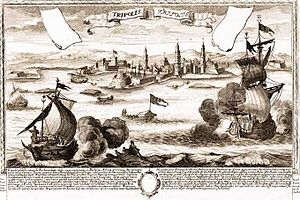Our website is made possible by displaying online advertisements to our visitors.
Please consider supporting us by disabling your ad blocker.
Siege of Tripoli (1551)
| Siege of Tripoli | |||||||||
|---|---|---|---|---|---|---|---|---|---|
| Part of the Ottoman-Habsburg wars and the Italian War of 1551–1559 | |||||||||
 Capture of Tripoli as illustrated in a 16th-century French engraving | |||||||||
| |||||||||
| Belligerents | |||||||||
|
|
| ||||||||
| Commanders and leaders | |||||||||
|
|
| ||||||||
| Strength | |||||||||
|
c. 10,000–12,000 men 145 ships |
c. 30–200 knights c. 500–630 men | ||||||||
| Casualties and losses | |||||||||
| Unknown |
200 men executed Some enslaved | ||||||||
The Siege of Tripoli was a successful Ottoman siege of the North African city of Tripoli, then held by the Knights Hospitaller, in August 1551. The attack, which was led by Sinan Pasha and Dragut, appears to have been launched in retaliation for the capture of Mahdia by the Spanish and Hospitallers the previous year.
The siege followed a brief Ottoman attack on the Kingdom of Sicily and Hospitaller Malta, during which the island of Gozo was invaded and sacked and some 5,000 to 7,000 inhabitants were taken as slaves. The Ottoman forces then sailed to North Africa, where they were bolstered by local forces from Tajura led by Murad Agha. Tripoli was besieged and the city's governor Gaspard de Vallier capitulated after six days of bombardment.
Through the intervention of French ambassador Gabriel d'Aramont, the Hospitaller knights and part of the garrison were allowed to depart Tripoli for Malta, while the rest of the garrison was massacred or enslaved. Murad Agha was appointed as beylerbey of Tripoli, and he was later succeeded in this position by Dragut. The latter transformed Tripoli into a major base for the Barbary corsairs and consolidated Ottoman control over Tripolitania, which lasted until the 20th century.
Previous Page Next Page
فتح طرابلس (1551) Arabic Asedio de Trípoli (1551) Spanish Prise de Tripoli (1551) French Pengepungan Tripoli (1551) ID Assedio di Tripoli (1551) Italian Опсада на Триполи (1551) MK Beleg van Tripoli (1551) Dutch Oblężenie Trypolisu (1551) Polish Cerco de Trípoli (1551) Portuguese Осада Триполи Russian


